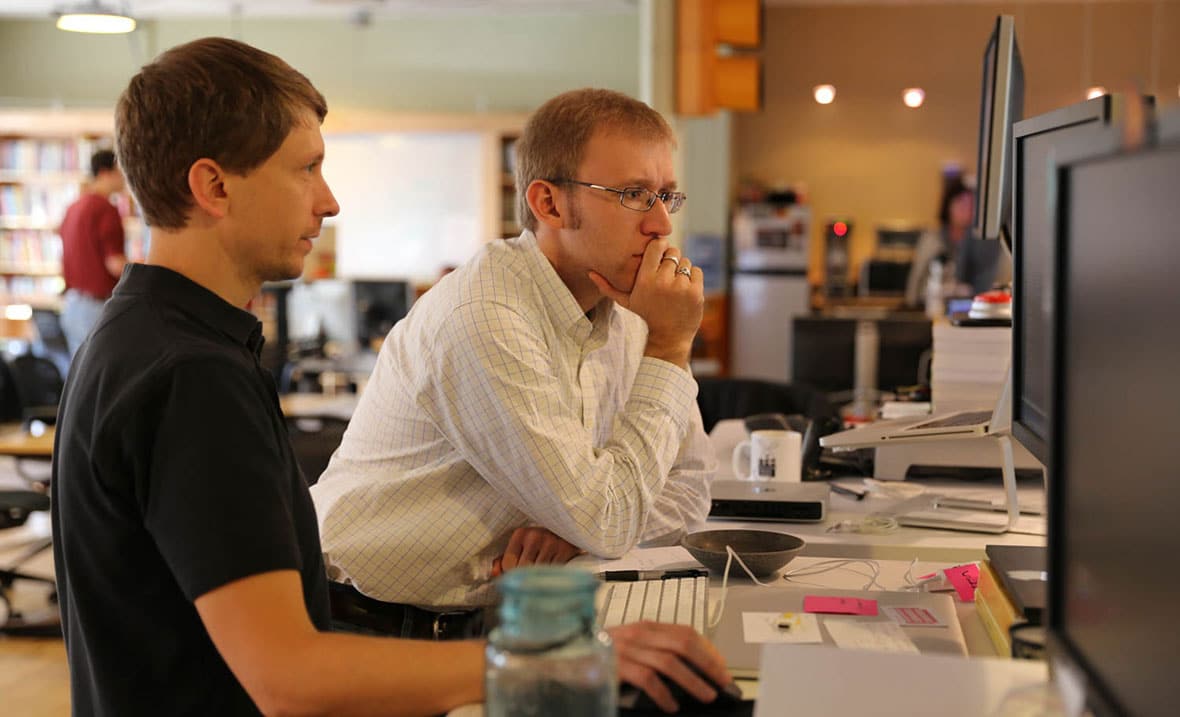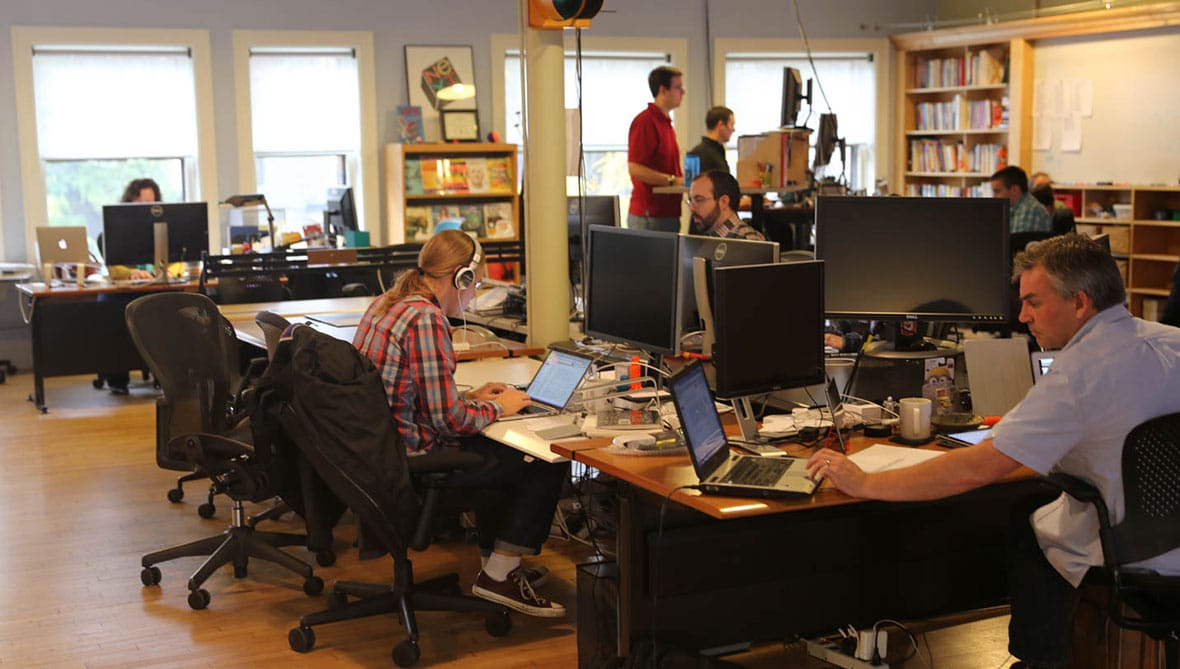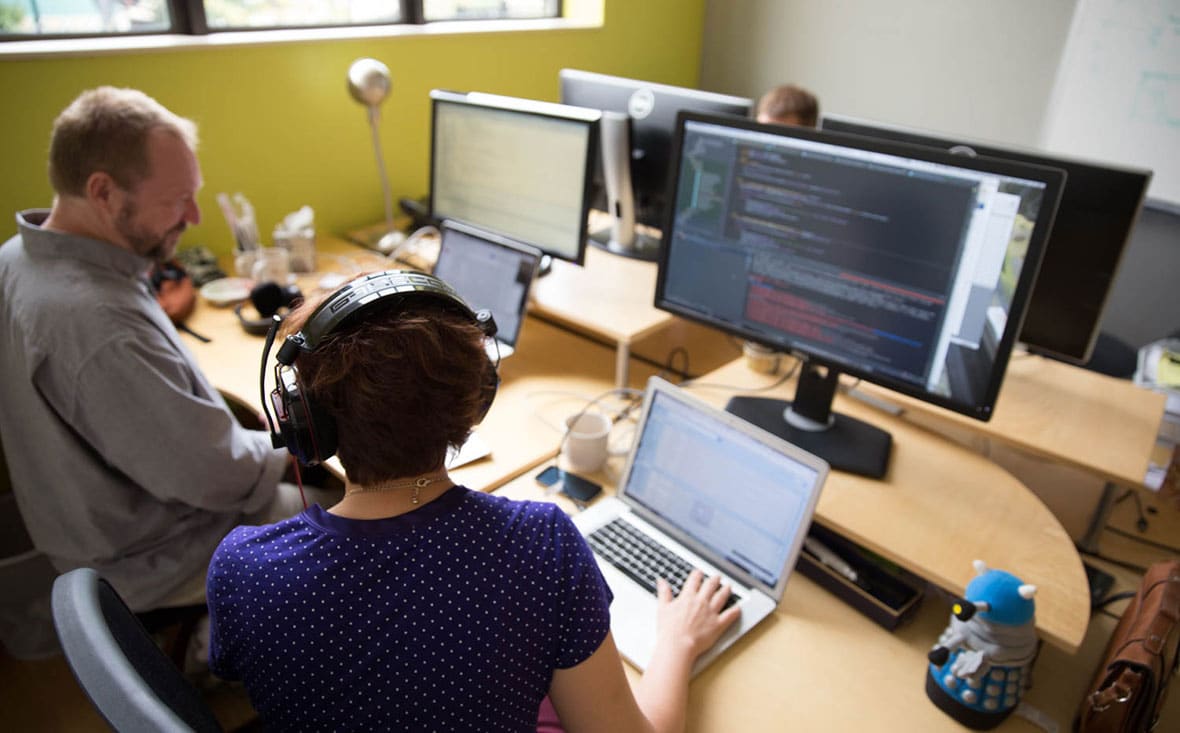Since 2001, Atomic has enjoyed and promoted the benefits of working in an open office environment. But over the past few years, many of us at Atomic have concluded that a purely open plan can be frustrating and stressful at times.
It was interesting to read Steelcase’s research in the October 2014 Harvard Business Review article “Balancing ‘We’ and ‘Me’” and discover that many of Steelcase’s findings match Atomic’s experiences and observations (for more insights from Steelcase see their publication, 360 issue 68 The Privacy Crisis).
Historical Perspective on Open Plan Workplace
At Atomic, we have historically believed that working in an open environment created a high degree of accountability and productivity. We also believed that our open environment allowed for easy access to others, the ability to get questions answered quickly, and serendipitous learning through crosstalk. But our beliefs were established when Atomic had fewer employees, occupancy density was less, and we were purely a software development company.
Outgrowing an Open-Plan Workplace
Atomic’s Grand Rapids office has grown in headcount, and the type of work we do has changed. Since 2009, we’ve grown from 22 employees in Grand Rapids to 31. With clients and guests, it’s not uncommon to have 35-40 people working in our office on any given day. In addition, our teams are doing much more than programming too:
- We have internal teams like our DevOps and marketing teams.
- Atomic has intentionally grown to become a software design and development company and, along the way, discovered that design activities have different space requirements than programming activities.
- Our embedded developers need more space for hardware than a web or mobile developer needs.
- The complexity of products we build has increased. We increasingly do a significant amount of remote work where space for phone calls and videoconferencing is necessary.
We eventually realized that our open-plan design wasn’t fully supporting the multiple modes of work we need to perform, and it wasn’t providing space for rejuvenation.
“Balancing ‘We’ and ‘Me'” notes that many others are finding open plan work environments stress employee privacy. The authors report that 74% of people surveyed in their study were more concerned for their privacy than they were 10 years ago (it was the late 1990’s when many companies started to switch to an open plan design). The authors break privacy into categories of information control (who sees what about my personal information, project information, etc.) and stimulation control (distractions, interruptions, concentration).
Outside of protecting client IP, information control is rarely a consideration at Atomic. One of our value mantras is to “Act Transparently.” Regardless of our office’s physical layout, we still have a strong belief in openness of information. However, I found that Atomic could identify with the issue of stimulation control.
Managing Stimulation Control
The authors acknowledge that stimulation control can be tricky to define as “one person’s distraction may be another’s comforting white noise” and that “on any given day, our notion of distraction can change.”
The authors turn to neuroscience to define three basic modes of attention:
- Controlled attention: Working on a focused task and intentionally avoiding distractions
- Stimulus-driven attention: Working on routine tasks (like email) and being open to interruptions
- Rejuvenation: Taking breaks from concentration, finding a quiet space, or being social with others
When you consider the three basic modes of attention, it’s no wonder why a fully open office environment can’t adequately support a diverse group of workers. It would be impossible to coordinate common modes of attention across a wide number of project teams and individuals who are at different points in their work.
It is interesting to consider that most work can be normalized into into one of the three modes of attention and that individual signaling and office planning can help people be more productive.
Organizational Strategies for Privacy at Work
I didn’t find much opportunity for Atomic to apply the Personal Strategies for Privacy outlined in “Balancing ‘We’ and ‘Me'” but I did find overlap with the Organizational Strategies for Privacy and what Atomic has already been discussing as an action plan.
Organizational Strategies for Privacy:
- Protocols: Shared understanding about behavior during certain time periods or in places
- Signaling: Individual behaviors communicating privacy boundaries
- Strategic space planning: Being thoughtful about physical proximity of areas allowing for different modes of attention (see article for information about the distributed and zone models)
- An ecosystem of spaces: Being sure to offer a variety of spaces that support all three modes of attention
Atomic has been discussing how we might want to create protocols to reduce interruptions. For example:
- Wear quiet shoes (we have hardwood floors)
- Take calls and videoconference sessions in conference rooms only
- Wear headphones if you want to listen to music
- Be mindful of the volume and carry of your voice
When it comes to signaling, we have let go of our historical no-headphones policy. We could get better when it comes respecting signaling. Two days ago, I found myself interrupting someone wearing headphones who was trying to catch up on work after being out of the office for two days (old habits die hard).
What I’m most excited about is Atomic’s recent work with Progressive AE. Atomic has been working with Progressive to renovate our Grand Rapids office with a strong emphasis on strategic space planning and creating an ecosystem of spaces. Progressive took a familiar Human-Centered design approach and studied how we worked in our space before creating design alternatives. Progressive used observation, surveys, and collaborative workshops to gain insights in what would be most suitable for Atomic. When “Balancing ‘We’ and ‘Me'” was published months after working with Progressive, I was intrigued and pleased to see similar conclusions and recommendations.
Are you happy with your workplace design? Does it support or hinder your productivity? Please share your comments and insights below.



